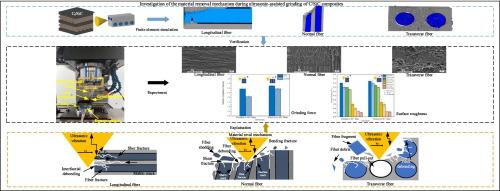Investigation of the material removal mechanism during ultrasonic-assisted grinding of C/SiC composites
IF 6.8
1区 工程技术
Q1 ENGINEERING, MANUFACTURING
引用次数: 0
Abstract
Ultrasonic-assisted grinding (UAG) offers significant advantages in machining carbon fiber reinforced silicon carbide (Cf/SiC) composites. These include substantial reduction in grinding force and improvement in surface quality. However, the strong anisotropy of Cf/SiC composites presents challenges. Current research on phase deformation and fracture mechanisms during UAG remains limited. As a result, the material removal mechanism is not well understood, which restricts further advancements in machining quality. In Response, a 3D finite element model of Cf/SiC composites was developed in Abaqus. Using this model, a single-grain abrasive grain UAG simulation was performed. The results demonstrated that grinding force magnitude critically influenced the damage to the carbon fibers and the SiC matrix, while the interfacial layer could impede and redirect crack propagation. Guided by these simulation results, UAG experiments on Cf/SiC composites were then conducted. Experimental verification revealed an average error of 11.8 % between simulated and measured grinding forces, demonstrating that the finite element model could accurately predict the experimental forces. The primary failure modes of Cf/SiC composites include longitudinal, transverse, and normal fiber damage. Ultrasonic vibration promoted brittle fracture of transverse fibers, reduced lateral fiber deflection, mitigated interfacial layer buckling, and suppressed fiber pull-out. Moreover, ultrasonic vibration altered the contact angle between abrasive grains and normal fibers. The high-frequency impacts of the abrasive grains in the normal direction accelerated cracks propagation along the fiber bending path, leading to shear fractures, and resulting in smoother, flatter fractured surfaces. For longitudinal fibers, the multidirectional compressive action of abrasive grains diminished bending fractures but intensified shear fractures, enabling localized fiber removal and inhibiting the formation of lateral cracks.

超声辅助磨削C/SiC复合材料材料去除机理研究
超声辅助磨削(UAG)在碳纤维增强碳化硅(Cf/SiC)复合材料的加工中具有显著的优势。这包括大幅度降低磨削力和改善表面质量。然而,Cf/SiC复合材料的强各向异性带来了挑战。目前对UAG过程中相变形和断裂机制的研究还很有限。因此,人们对材料的去除机理还不太了解,这限制了加工质量的进一步提高。为此,在Abaqus中建立了Cf/SiC复合材料的三维有限元模型。利用该模型对单粒磨粒UAG进行了数值模拟。结果表明,磨削力大小对碳纤维和碳化硅基体的损伤有重要影响,而界面层会阻碍和改变裂纹的扩展方向。在模拟结果的指导下,对Cf/SiC复合材料进行了UAG实验。实验验证表明,模拟磨削力与实测值的平均误差为11.8%,表明有限元模型能够准确预测磨削力。Cf/SiC复合材料的主要破坏模式包括纵向、横向和正常纤维损伤。超声振动促进横向纤维脆性断裂,减少横向纤维挠曲,减轻界面层屈曲,抑制纤维拔出。此外,超声振动改变了磨粒与普通纤维之间的接触角。磨粒在法向的高频冲击加速了裂纹沿纤维弯曲路径的扩展,导致剪切断裂,从而产生更光滑、更平坦的断裂表面。对于纵向纤维,磨粒的多向压缩作用减少了弯曲断裂,但加剧了剪切断裂,从而实现了纤维的局部去除,抑制了横向裂纹的形成。
本文章由计算机程序翻译,如有差异,请以英文原文为准。
求助全文
约1分钟内获得全文
求助全文
来源期刊

Journal of Manufacturing Processes
ENGINEERING, MANUFACTURING-
CiteScore
10.20
自引率
11.30%
发文量
833
审稿时长
50 days
期刊介绍:
The aim of the Journal of Manufacturing Processes (JMP) is to exchange current and future directions of manufacturing processes research, development and implementation, and to publish archival scholarly literature with a view to advancing state-of-the-art manufacturing processes and encouraging innovation for developing new and efficient processes. The journal will also publish from other research communities for rapid communication of innovative new concepts. Special-topic issues on emerging technologies and invited papers will also be published.
 求助内容:
求助内容: 应助结果提醒方式:
应助结果提醒方式:


